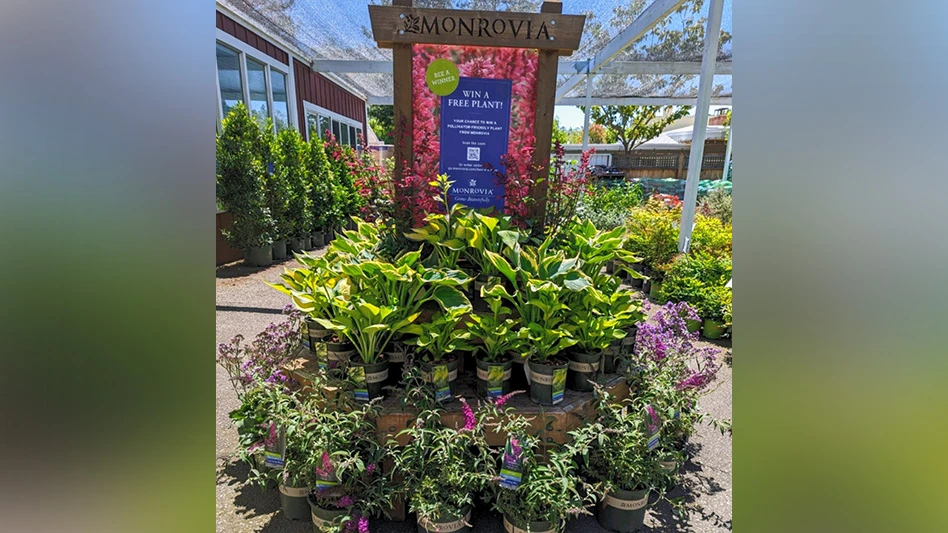 Rainwater collection systems usually involve using gutter systems from building roofs to collect in above- or below-ground storage barrels or cisterns. Check www.harvesth2o.com to see if there are incentives in your state for installing a rainwater harvesting system. Photo courtesy of Central Coast Bioneers |
Rainwater harvesting isn’t just for gardeners anymore. Growers are putting large-scale commercial systems in place to ensure their water resources stay plentiful without having to deal with all the red tape that inevitably comes with water restrictions from local municipalities and states.
Rainwater harvesting (RWH) is a method of collecting rainwater from the roofs of buildings or other catchment surfaces and sending it to storage for future use. Because rainwater is a free resource and typically one of high quality and nutrition, growers are seeing benefits to installing harvesting systems.
Installing a system What’s a better structure for collecting rainwater than a commercial greenhouse? They have high, angled roofs and gutter systems already in place, existing retention ponds at many locations and irrigation systems ready to take advantage of this high-quality water source. Rainwater harvesting makes perfect sense for commercial horticulture.
Rainwater collection systems vary depending on the site, but they typically involve using a gutter system from building roofs to collect in above- or below-ground storage barrels or cisterns. From there, growers can use an infrastructure of pumps and pipes to deliver water to irrigation systems.
Storage volume is a balance between local site environmental conditions, project budget and overall water supply goals. Properly balancing demand with collection potential will offer longer term success with a rainwater system.
 Photo courtesy of Central Coast Bioneers |
In selecting a cistern, growers should consider the following:
- Required or desired storage capacity
- Type of cistern: above or below ground, wood, steel, PE, concrete
- Preferred diameter and height. Are there restrictions to size? Measure the area available for tank installation.
- Specific project or delivery location information and instructions
- Desired schedule for delivery or completion
- Pipe sizes. Inlet, outlet, overflow drain and location
- Accessories: it’s more cost-effective to purchase accessories at the same time as ordering the tank. Consider tank access and ladders, water level indicators and controls.
- Snow loading or special wind conditions.
Rainwater is essentially purified water from the sky in the form of condensed water vapor, making it a very high-quality water source. But once it hits the catchment surface and flows into the drainage pipes, it can become contaminated with biological, chemical and physical properties. Reducing these contaminants through screening, filtering and water treatment is key to maintaining good water quality for use as greenhouse irrigation water.
 |
RWH evaluations
If you are unsure of whether or not installing a rainwater harvesting system makes sense for your operation, ask another grower. According to Paul Fisher, associate professor and extension specialist at University of Florida, some big players in horticulture are currently in the process of installing collection systems.
“Rainwater collection systems are absolutely viable for commercial greenhouse operations,” Fisher said. “A very good example of a large-scale greenhouse that recently completed installation of such a system is Metrolina Greenhouses in North Carolina. There are other growers setting themselves up to this, as well. Lucas Greenhouses in New Jersey is in the process of building all the infrastructure.”
Fisher adds that in his own state, Agri-Starts, based in Apopka, Fla., is in the process of building a rainwater collection system.
“It is risk management,” Fisher said. “A rainwater harvesting system allows you to be independent of regulators, have your own water system and be less vulnerable to restrictions. It’s getting harder for growers to put down new wells and compete with other aspects of society for water, especially potable water for drinking. Plus, rainwater is very good quality, so it makes great sense.”
|
Growing media characteristics impact water conservation
Worksheet A. _______________ = Total porosity B. _______________ = Air space at saturation C. Water retention = A-B ______________ D. (B x 100) ÷ A = Percent air space at saturation _______________ E. (C x 100) ÷ A = Percent water retention
|
Benefits, incentives
With all of the incentive programs in place nationwide, it’s likely your system could be funded with a grant, and the benefits don’t stop there. For growers interested in LEED certification through the U.S. Green Building Council’s Leadership in Energy and Environmental Design program, water use reduction is a critical element. Rainwater harvesting is a simple, low-cost solution that can offer further savings once installed. Learn more by visiting the USGBC website at www.usgbc.org.
To learn about incentives offered by state, visit the Harvest H2O website at www.harvesth2o.com. Some states, like Ohio, don’t offer any incentives; however, in states like California, Florida and Colorado where water is at a premium and growers have to compete for water due to heavy restrictions, incentives and grants for RWH are abundant.
Michael Kovalycsik is national sales and marketing director at Delta T Solutions.
 Tampa Wholesale uses recycled water from a neighboring fishery.Photo courtesy of Florida Department of Agriculture and Consumer Services’ Division of Marketing and Development |
Tampa Wholesale Nursery
Tampa Wholesale Nursery in Dover, Fla., uses recycled water from a neighbor, Tampa Bay Fisheries. It’s one of the largest seafood packaging companies in the U.S. and it’s just a mile from the nursery. The plant produces about 1.7 million pounds of seafood a week and uses approximately 200,000 gallons of water daily. While it has its own wastewater treatment plant and spray fields, business growth prompted the company to seek additional ways of disposing of excess water.
As the water leaves the seafood processing plant, it goes through a screening process before going into Tampa Bay Fisheries’ wastewater treatment plant. From there it flows into a treatment pond where it is held until it is pumped through a mile-long pipeline into Tampa Wholesale Nursery’s two-acre reservoir. Since implementing the process, the amount of water Tampa Wholesale Nurseries draws from the aquifer has decreased by at least 40 percent.
For more: www.tampawholesalenursery.com
Greenheart Farms
Greenhart Farms in Arroyo Grande, Calif., has adopted several water conservation methods.
- The nursery works closely with the Natural Resources Conservation Service (NRCS). It currently has 100,000 square feet of rain vaults, and the grower is working on building another 126,000 square feet. When rain hits the poly of the greenhouses, it runs off and is collected into underground rain vaults and stored in green tanks on both the east and the west side of the property. This water is then used in the company’s landscapes and put back into the ground.
- No irrigation or rainwater runs off the property.
- Greenheart uses flood irrigation on all the benches in its rose greenhouses. All the water is collected, sent through a series of filters and treated with ozone. Then it’s ready to be reused in production.
For more: www.greenheartfarms.com
Eastern Shore Nursery of Virginia
Following years of commitment to responsible growing practices that promote water conservation and reduce pollution and runoff, Eastern Shore Nursery of Virginia launched its Greener Plants brand.
The nursery’s aim is to encourage consumers to adopt environmentally responsible growing practices at home that will help clean up and preserve America’s watersheds.
“We expect this to increase demand for greener plants and the products that go with them,” says Nick Covatta, co-owner of the nursery.
A percentage of every plant sold from the Green Plants line is given to the Chesapeake Bay Foundation.
For more: www.greenerplants.com
 |
Bracy’s Nursery
Bracy's Nursery in Amite, La., built a plant brand to help its customers get through a debilitating drought. Bracy’s Backyard Oasis, a program containing drought-tolerant plants, specialty tags and supporting point-of-purchase material, let consumers know that it was OK to garden, even during a drought.
“Our customers were going through a terrible time, and we wanted to find a way to help them,” says Randy Bracy, founder of the nursery.
The program contains more than 250 plants, which are gauged on survivability during drought.
For more: www.bracys.com

Explore the July 2013 Issue
Check out more from this issue and find your next story to read.
Latest from Garden Center
- This Florida garden center's busiest days are in the fall, not spring. Find out how they do it
- Terra Nova Nurseries releases new agastache variety, 'Peach Pearl'
- The Certified Shopify Online Garden Center provides local retailers with ecommerce tool
- Meet the All-America Selections AAS winners for 2025
- Endless Summer hydrangeas and Suntory Senetti glam up Grammys red carpet
- Ball Seed releases 2025 edition of 'Thrive and Flourish' for landscape and garden retail
- American Floral Endowment's Fred C. Gloeckner Foundation Research Fund accepting grant proposals
- Floral Marketing Fund and CalFlowers partner to advance floral industry





